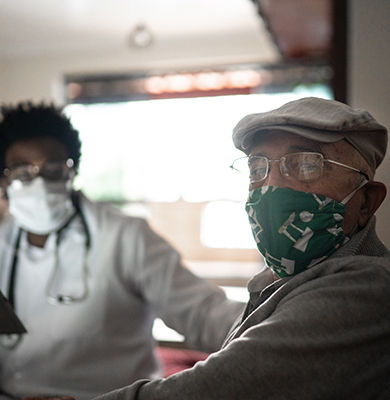WHAT WE'RE LEARNING
Dear Colleagues—
We have all seen disturbing headlines regarding the coronavirus’ effect on America’s nursing homes. What we don’t hear enough about are the innovative, heroic steps that nursing home staff, residents, families, and their community, state, and federal partners are taking to work together and implement solutions. Like how, each day, hard work is happening to keep nursing home residents and staff safe. We are learning about that work first-hand through the COVID-19 Rapid Response Network for Nursing Homes, one of several initiatives we’ve launched to support both immediate response and longer-term change so that nothing like this happens again.
We launched the Rapid Response Network with the Institute for Healthcare Improvement (IHI) as part of our Age-Friendly Health Systems movement. We began the first week in May with daily 20-minute webinar huddles for frontline staff. More than 1,800 people have registered to date and have access to easy-to-use resource materials on topics ranging from COVID-19 testing and infection control to advance care planning and social isolation. Each weekday, 120 to 150 people have joined the national nursing home huddles to share knowledge, skills, resources, and references that help create sound processes and actionable systems of care during the pandemic.
The daily huddles, featuring leading experts, have provided incredible insight into what nursing home care providers need and how peer-to-peer learning supports them. On every call, these experts provide information on the latest coronavirus science, epidemiological data, and evolving policies from CMS, CDC, and other federal and state partners. The ensuing conversation among participants almost always results in innovative, implementable solutions to common challenges that can be operationalized immediately.
We saw wonderfully creative examples from nursing homes across the country for infection control, preventing resident cognitive and functional decline, reducing social isolation, supporting family members, and much more:
- One nursing home used finger paint on staff members’ hands to demonstrate how infection can spread while putting on or taking off dressing gowns and other PPE.
- Simple actions, such as staff dancing while delivering meals or musicians playing in centrally located courtyards, can create more dynamic environments.
- Laughter “exercises” can help residents with dementia, who are at particularly high risk for decline.
- Chair fitness classes, walking groups, and “Adopt-a-Plant” programs can support residents in remaining active and mobile.
- Hosting a community parade allowed family and neighbors to drive by and safely see residents and show support for nursing home staff.
- Supporting family members’ creativity can pay off in big ways, too. One family rented a cherry picker so that they and others could visit their loved ones through windows on higher floors.
The sense of community generated though the huddles has resulted in the emergence of a trusted forum for participants to discuss some of the more frustrating aspects of the pandemic response, including justifiable anger about how nursing homes have historically not been part of public health strategies, including emergency preparedness planning and response.
In one huddle, nursing home managers from Florida and Texas were quick to point out federal and state lapses in responding to hurricanes Harvey and Katrina, and what should have been learned from those experiences. Not integrating nursing homes in emergency preparedness planning and response, as witnessed during COVID-19, puts residents and staff at a dangerous disadvantage when it comes to testing, PPE, and decisions about safety.
An essential learning from the huddles that must be operationalized in the future is that an effective response requires public and private sectors sharing information so they can together form a comprehensive yet timely response. No one can do it alone.
The huddles allow for important conversations about what went wrong, augmented by equally important insights into what went right. All of that information will help inform another significant initiative that we are supporting with the National Academies of Sciences, Engineering, and Medicine, which will conduct a national consensus study to guide federal nursing home policy and practice for years to come. A call for nominations was just released for the Committee on Quality and Safety in Nursing Homes that will begin work this fall.
Meanwhile, the IHI national nursing home huddles are transitioning to twice weekly starting in September and are in the planning stage to integrate with a new, large-scale, federally funded initiative with Project ECHO, a consortium of hundreds of health system “hubs” located across the United State that are expert in delivering tele- and video-based training and technical assistance. Building on a current pilot with nursing homes, the IHI-partnered hubs will offer support on infection control, clinical care improvement, and other key topics.
Our Foundation is committed to ensuring that nursing home leadership and frontline workers are included in forging solutions and preparing for whatever comes next. We are heartened by the ongoing and future work dedicated to supporting nursing home residents and staff through the pandemic and beyond. Through partnership we will prevail.
Sincerely,
Terry Fulmer, PhD, RN, FAAN
President, The John A. Hartford Foundation

